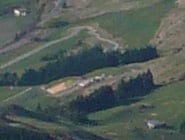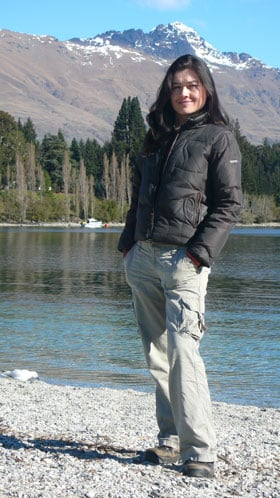Panasonic Lumix DMC-LX2
-
-
Written by Gordon Laing
Panasonic DMC-LX2 gallery
The following images were taken with the Panasonic Lumix LX2. The quality was set 10M Fine (16:9) mode, Auto White Balance, and Multiple Metering, with all four Picture Adjustment options including Noise Reduction set to Standard. The individual exposure mode, file sizes, shutter speeds, aperture, ISO and lens focal length are listed for each image.
The crops are taken from the original files, reproduced at 100% and saved in Adobe Photoshop CS2 as JPEGs with the default Very High quality preset, while the resized images were made in Photoshop CS2 and saved with the default High quality preset. The three crops are typically taken from far left, central and far right portions of each image.
Landscape: 4.8MB, Program, 1/500, f6.3, ISO 100, 6.3-25.2mm at 8mm (equivalent to 36mm)
|
Huge landscape vistas are what the LX2’s all about. The wide 16:9 mode is ideal for capturing this kind of scene and it’s immediately more emotive than a narrower aspect ratio. Look closely at the crops though and you’ll see plenty of noise. This is a concern since the shot was taken under bright conditions at the LX2’s lowest sensitivity of 100 ISO. As you’ll see, noise and noise reduction are the LX2’s biggest problems. | ||||||||||||||||
Harbour: 4.73MB, Normal, 1/400, f6.3, ISO 100, 6.3-25.2mm at 6.3mm (equivalent to 28mm)
|
Anyone familiar with the Cameralabs galleries will have seen this shot before, but never with the entire sail visible. Once again this is the benefit of having a 16:9 sensor with a wide lens equivalent to 28mm. Once again though, there’s quite a lot of noise visible in the crops, despite the bright light and low sensitivity. | ||||||||||||||||
Landscape: 4.48MB, Program, 1/400, f7.1, ISO 100, 6.3-25.2mm at 21mm (equivalent to 93mm)
|
The LX2’s 16:9 aspect ratio is just fantastic for shots like these and continues to inspire you the more you use it; it’s also simply great fun to shoot pictures with the widescreen display. The pictures look equally great filling the camera’s screen, but once you start zooming-in, noise once again raises its ugly head. Here again we’ve shot at 100 ISO under bright light, yet noise speckles and smearing of detail is quite evident on the crops. | ||||||||||||||||
Landscape: 4.33MB, Shutter Priority, 1/30, f3.6, ISO 800, 6.3-25.2mm at 12mm (equivalent to 53mm)
|
To test the LX2’s low light and flash capabilities we shot this outdoor concert, and manually selected a shutter of 1/30 and sensitivity of 800 ISO to ensure some background was visible. The exposure, as with other LX2 shots, is impeccable, but anyone can see there’s serious noise issues when viewed at 100%. And while you could argue this wouldn’t be as noticeable on smaller prints or lesser magnifications, we’d then have to ask, what’s the point in having a 10 Megapixel camera? | ||||||||||||||||
Left: 4.56MB, Program, 1/320, f5.6, ISO 100, 6.3-25.2mm at 18mm (equivalent to 80mm)
Right: 4.49MB, Program, 1/500, f8, ISO 100, 6.3-25.2mm at 10mm (equivalent to 44mm)
|
The LX2’s 16:9 mode isn’t just about landscape orientation, or indeed just landscapes. Turn it around and you can have quite a lot of fun. On the left we’ve taken a full-length portrait without acres of space on either side, while the composition on right has accentuated the height of the boat. The 16:9 shape on its side would be equally effective for tall buildings. Again though the 100% crops reveal considerable noise, even though both shots were taken under very bright conditions with the LX2’s lowest sensitivity. It’s a real shame, as the lens is sharp, the metering accurate and the 16:9 aspect ratio inspiring. Unfortunately the sensor and processing let it down. These samples at 100 ISO under bright light are as good as it gets. | ||||||||||||||||||


























